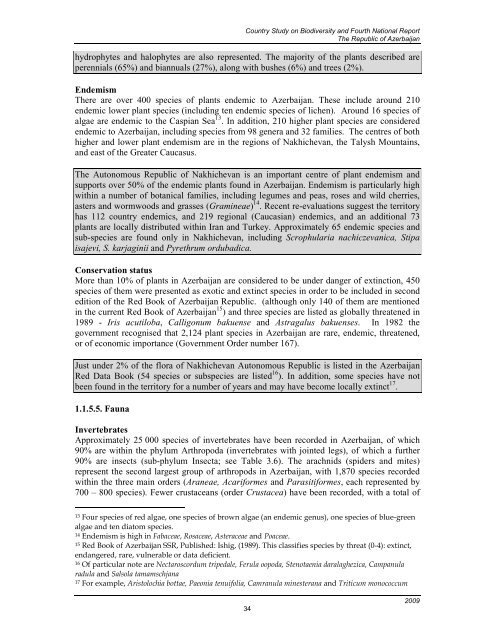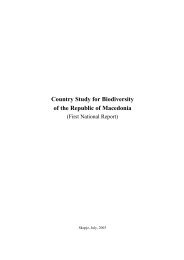CBD Fourth National Report - Azerbaijan (English version)
CBD Fourth National Report - Azerbaijan (English version)
CBD Fourth National Report - Azerbaijan (English version)
Create successful ePaper yourself
Turn your PDF publications into a flip-book with our unique Google optimized e-Paper software.
Country Study on Biodiversity and <strong>Fourth</strong> <strong>National</strong> <strong>Report</strong><br />
The Republic of <strong>Azerbaijan</strong><br />
hydrophytes and halophytes are also represented. The majority of the plants described are<br />
perennials (65%) and biannuals (27%), along with bushes (6%) and trees (2%).<br />
Endemism<br />
There are over 400 species of plants endemic to <strong>Azerbaijan</strong>. These include around 210<br />
endemic lower plant species (including ten endemic species of lichen). Around 16 species of<br />
algae are endemic to the Caspian Sea 13 . In addition, 210 higher plant species are considered<br />
endemic to <strong>Azerbaijan</strong>, including species from 98 genera and 32 families. The centres of both<br />
higher and lower plant endemism are in the regions of Nakhichevan, the Talysh Mountains,<br />
and east of the Greater Caucasus.<br />
The Autonomous Republic of Nakhichevan is an important centre of plant endemism and<br />
supports over 50% of the endemic plants found in <strong>Azerbaijan</strong>. Endemism is particularly high<br />
within a number of botanical families, including legumes and peas, roses and wild cherries,<br />
asters and wormwoods and grasses (Gramineae) 14 . Recent re-evaluations suggest the territory<br />
has 112 country endemics, and 219 regional (Caucasian) endemics, and an additional 73<br />
plants are locally distributed within Iran and Turkey. Approximately 65 endemic species and<br />
sub-species are found only in Nakhichevan, including Scrophularia nachiczevanica, Stipa<br />
isajevi, S. karjaginii and Pyrethrum ordubadica.<br />
Conservation status<br />
More than 10% of plants in <strong>Azerbaijan</strong> are considered to be under danger of extinction, 450<br />
species of them were presented as exotic and extinct species in order to be included in second<br />
edition of the Red Book of <strong>Azerbaijan</strong> Republic. (although only 140 of them are mentioned<br />
in the current Red Book of <strong>Azerbaijan</strong> 15 ) and three species are listed as globally threatened in<br />
1989 - Iris acutiloba, Calligonum bakuense and Astragalus bakuenses. In 1982 the<br />
government recognised that 2,124 plant species in <strong>Azerbaijan</strong> are rare, endemic, threatened,<br />
or of economic importance (Government Order number 167).<br />
Just under 2% of the flora of Nakhichevan Autonomous Republic is listed in the <strong>Azerbaijan</strong><br />
Red Data Book (54 species or subspecies are listed 16 ). In addition, some species have not<br />
been found in the territory for a number of years and may have become locally extinct 17 .<br />
1.1.5.5. Fauna<br />
Invertebrates<br />
Approximately 25 000 species of invertebrates have been recorded in <strong>Azerbaijan</strong>, of which<br />
90% are within the phylum Arthropoda (invertebrates with jointed legs), of which a further<br />
90% are insects (sub-phylum Insecta; see Table 3.6). The arachnids (spiders and mites)<br />
represent the second largest group of arthropods in <strong>Azerbaijan</strong>, with 1,870 species recorded<br />
within the three main orders (Araneae, Acariformes and Parasitiformes, each represented by<br />
700 – 800 species). Fewer crustaceans (order Crustacea) have been recorded, with a total of<br />
13 Four species of red algae, one species of brown algae (an endemic genus), one species of blue-green<br />
algae and ten diatom species.<br />
14 Endemism is high in Fabaceae, Rosaceae, Asteraceae and Poaceae.<br />
15 Red Book of <strong>Azerbaijan</strong> SSR, Published: Ishig, (1989). This classifies species by threat (0-4): extinct,<br />
endangered, rare, vulnerable or data deficient.<br />
16 Of particular note are Nectaroscordum tripedale, Ferula oopoda, Stenotaenia daralaghezica, Campanula<br />
radula and Salsola tamamschjana<br />
17 For example, Aristolochia bottae, Paeonia tenuifolia, Camranula minesterana and Triticum monococcum<br />
34<br />
2009

















